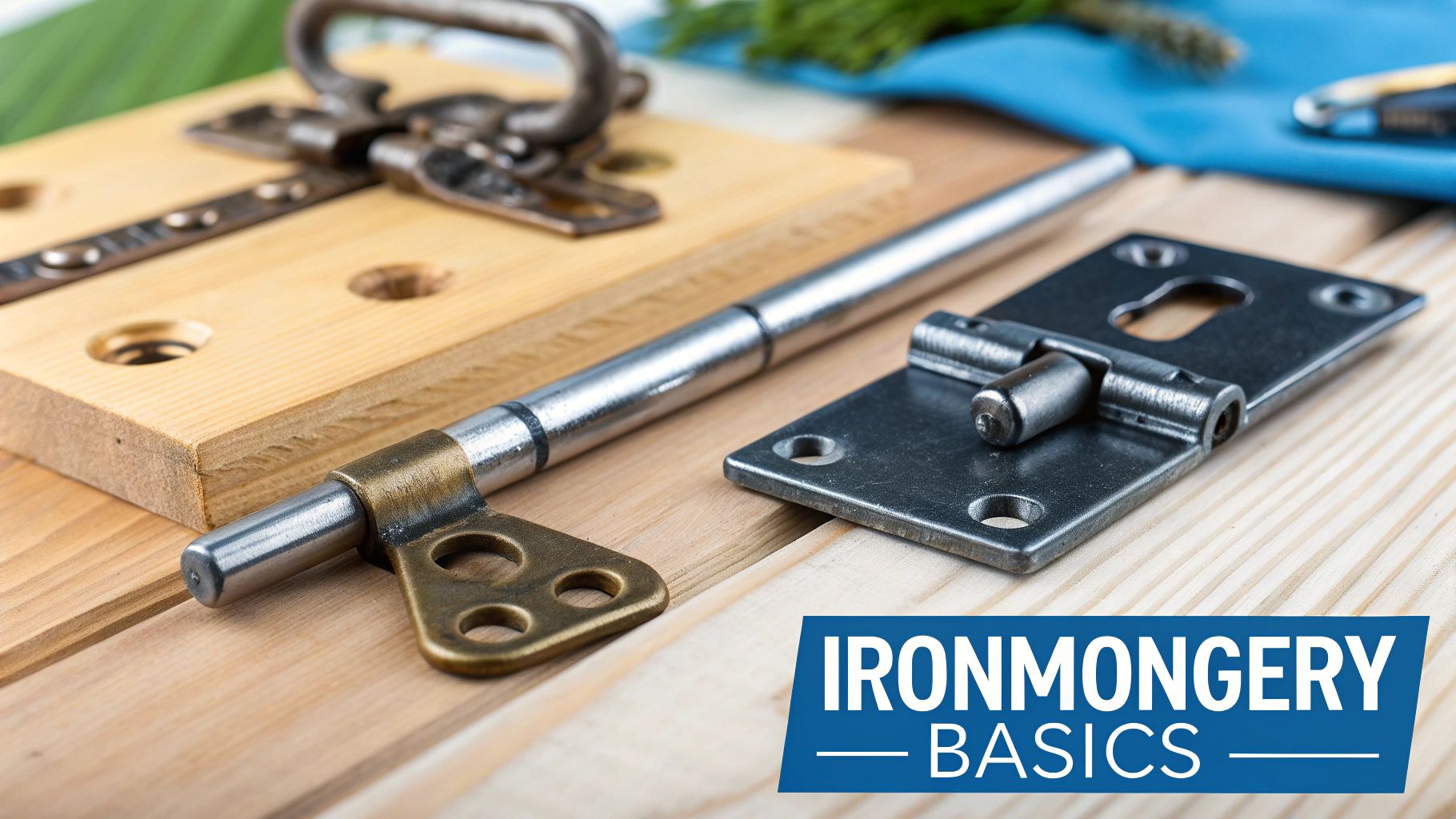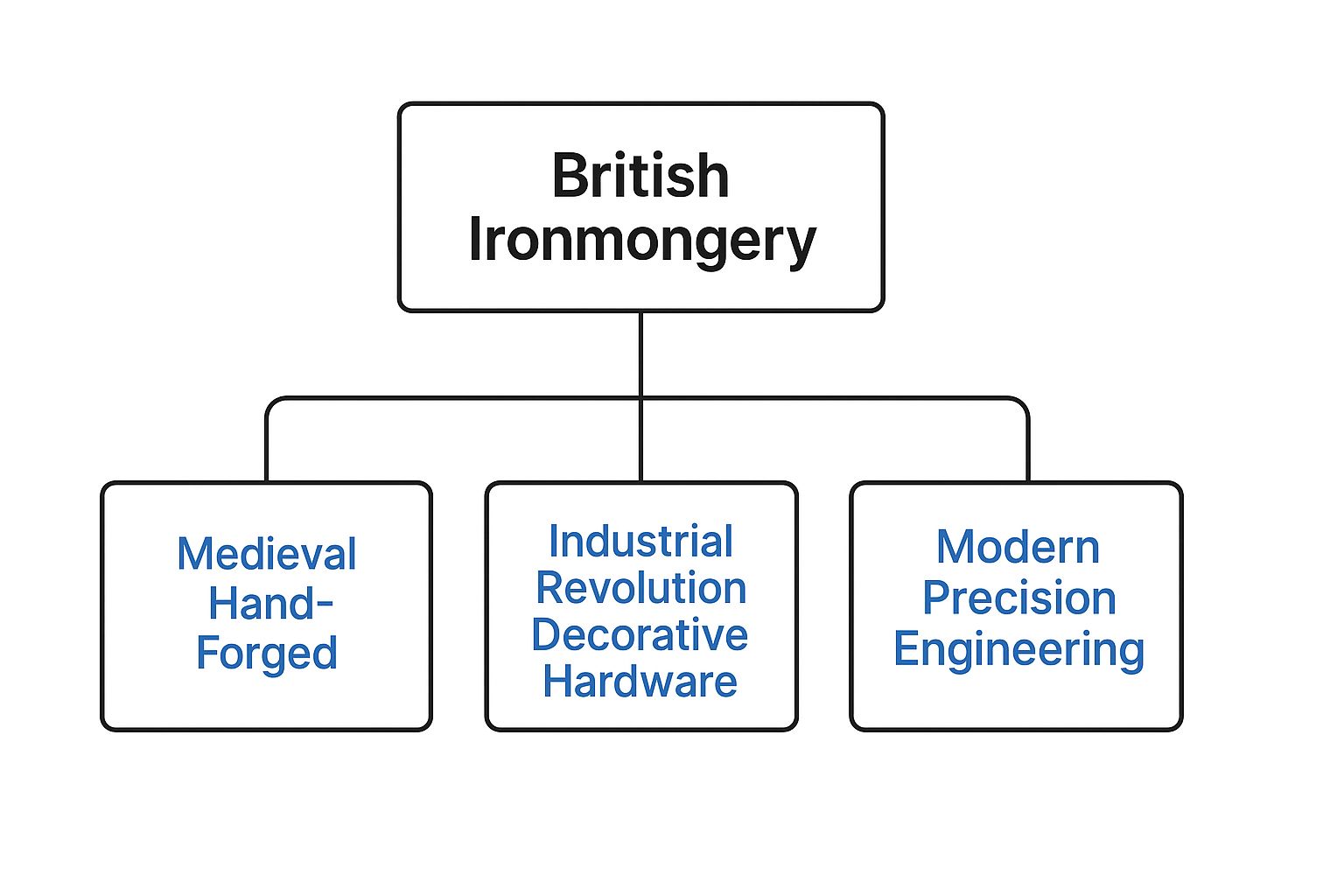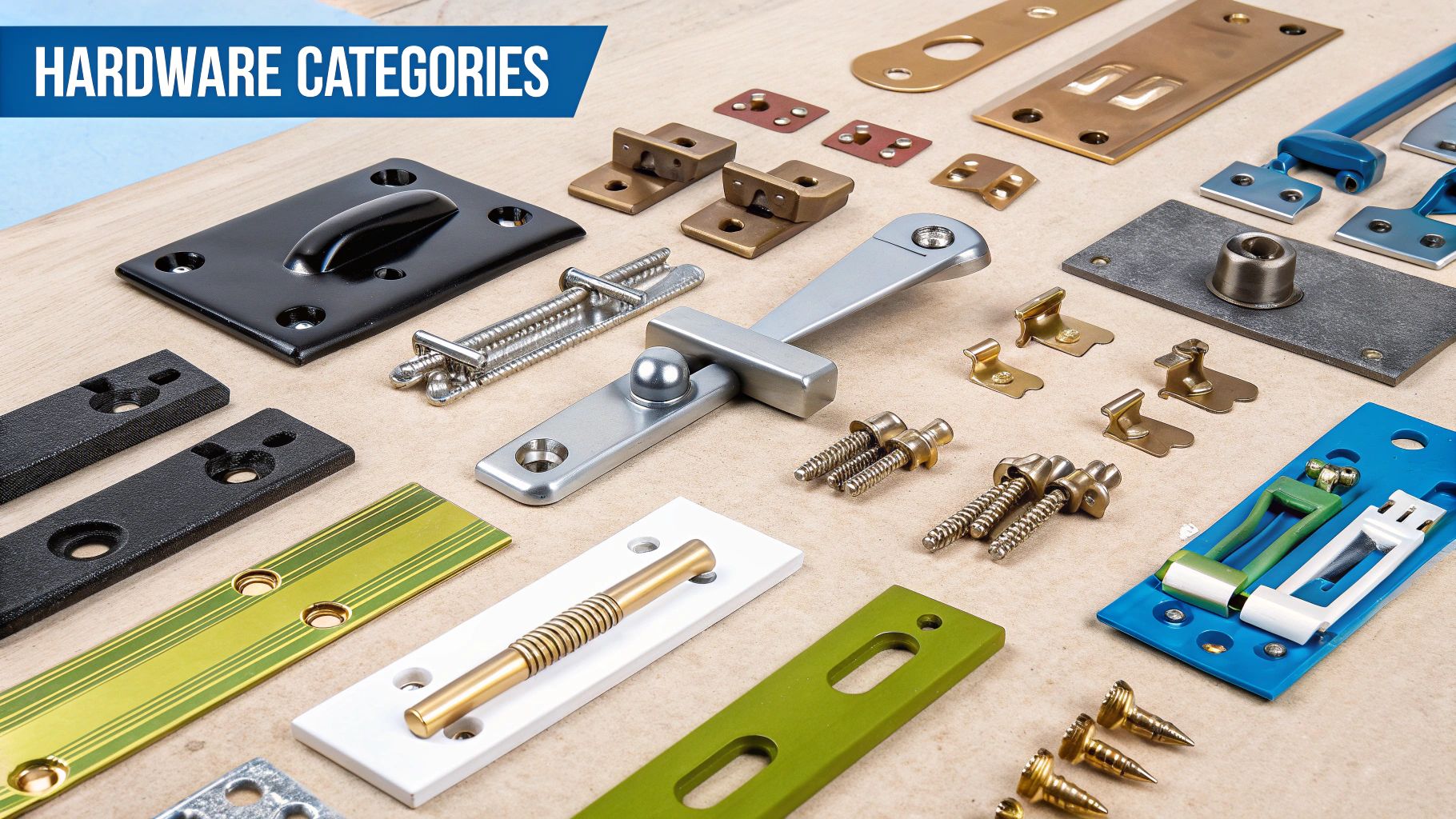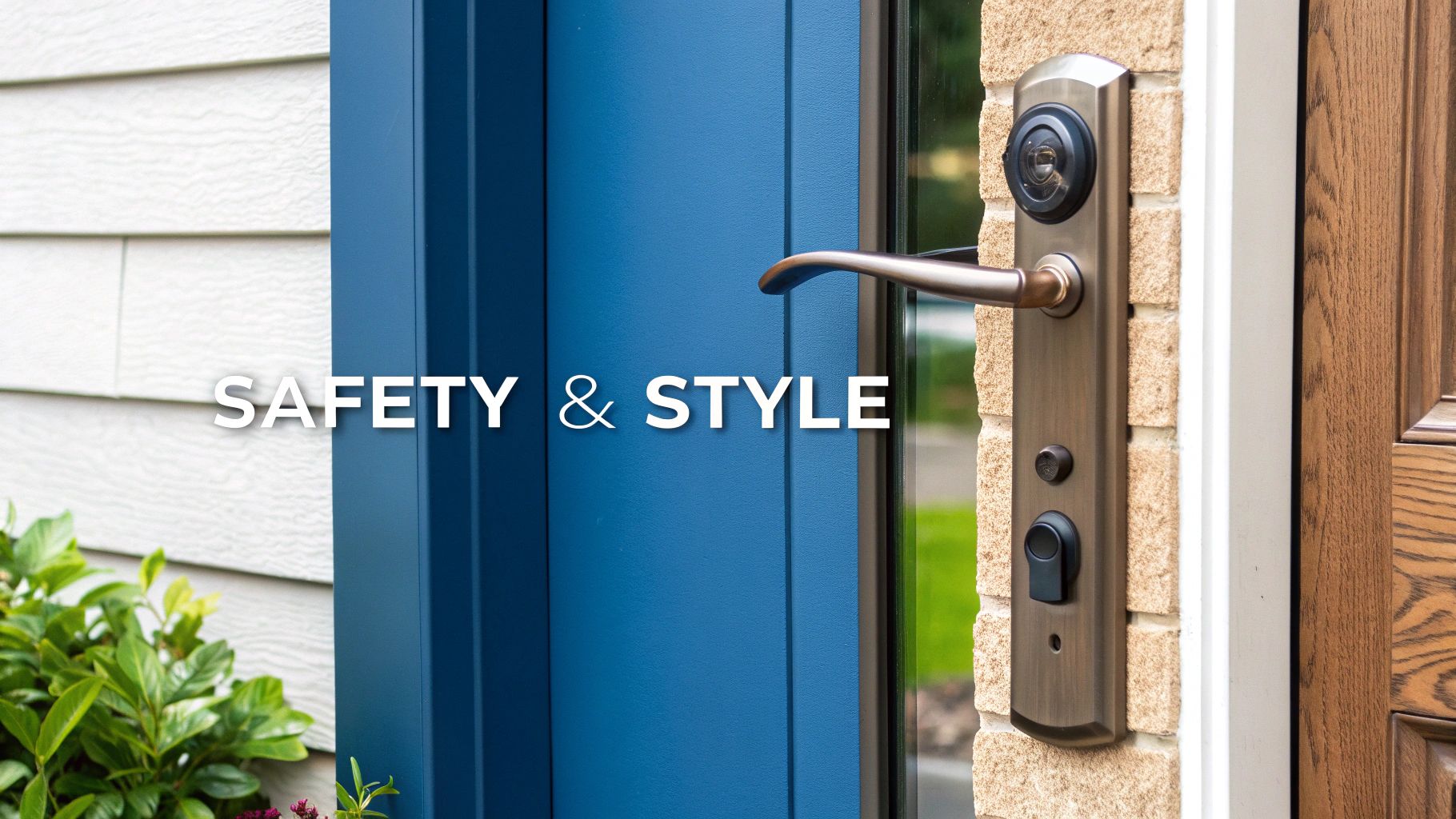- Straight to your door!
Straight to your door

At its heart, ironmongery is the trade term for all the metal hardware that makes a building tick. It’s the collection of bits and pieces—from door handles and hinges to locks and latches—that allow a space to function, giving it security, accessibility, and a touch of style.

Think of ironmongery as the joints and touchpoints of your home. A body needs joints to move, and a building is no different—it relies on hinges to swing doors, window stays to hold windows open, and latches to keep cupboards shut. These parts are easy to overlook, but without them, a building would just be a static, unusable shell.
The term covers a massive range of items essential for both construction and interior design. Here in the UK, it specifically refers to the manufacture and supply of all this metal hardware. It's a surprisingly big deal; the lock and hinge manufacturing sector alone is estimated to pull in revenues of around £975.1 million.
Ironmongery really serves two key purposes: functionality and aesthetics. On the functional side, these items are the workhorses of a property. They secure, connect, and enable movement, day in and day out.
But they're also the finishing touches that pull a design scheme together. Choosing a sleek, matte black door handle over an ornate, polished brass one can completely transform the feel of a room. For a deeper dive into how these small details make a big impact, this comprehensive cabinet hardware guide is a great resource.
Ironmongery is more than just metal fittings; it's the critical link between a building's structure and its daily usability. It provides security, enables movement, and defines the final aesthetic, making it one of the most important details in any construction or renovation project.
To really get to grips with what ironmongery is, it helps to see how everything is grouped. While our full ironmongery collection shows just how much variety there is, most items fall into a few key categories.
The world of ironmongery can feel vast, but it’s easy to navigate once you break it down. The table below summarises the main groups you'll encounter and what they're used for.
| Category | Primary Function | Common Examples |
|---|---|---|
| Door Furniture | To operate and secure doors while adding decorative style. | Lever Handles, Doorknobs, Letter Plates, Escutcheons |
| Window Hardware | To secure, open, and close windows safely and easily. | Fasteners, Window Stays, Sash Lifts, Window Locks |
| Hinges & Pivots | To allow doors, gates, and cupboards to swing open and shut. | Butt Hinges, Concealed Hinges, Pivot Hinges, T-Hinges |
| Locks & Security | To provide security and control access to a property or room. | Mortice Locks, Cylinder Locks, Night Latches, Bolts |
From the handle you grab every day to the lock that keeps you safe at night, each piece plays a vital role in making a house a home.
Every handle, hinge, and lock tells a story. The history of British ironmongery isn't just about bits of metal; it’s a fascinating journey that mirrors the nation's architectural and social changes, shifting from raw function to intricate form and back again. Understanding this evolution gives you a much deeper appreciation for the hardware we use every single day.
It all started with the hefty, hand-forged fittings of medieval castles and manors. Back then, ironmongery was born from pure necessity. Blacksmiths hammered out robust, functional pieces like strap hinges, bolts, and simple latches designed for one thing: strength and security. These items were often crude by today's standards, but they were built to last for centuries, prioritising durability above all else.
The Industrial Revolution was a complete game-changer for ironmongery. Suddenly, mass production techniques made decorative hardware accessible to the growing middle class, not just the aristocracy. Ornate brass, intricate cast iron, and polished finishes became the hallmarks of the Victorian era, as homeowners were eager to show off their newfound prosperity through detailed and stylish fittings.
Functionality was still important, of course, but it was now dressed up with an incredible level of decoration. This period gave us the elaborate doorknobs, decorative escutcheons, and detailed window stays that still define classic British period properties.
The infographic below shows the key stages in the development of British hardware.

This visual journey really highlights the shift from purely functional, handcrafted items to mass-produced decorative hardware, and finally to the precision-engineered solutions we see today.
The 20th century, especially the post-war period, saw a major swing back towards functionalism. Influenced by modernist design principles, the focus returned to simplicity, clean lines, and practicality. Materials like aluminium and early forms of stainless steel grew in popularity for their clean look and low maintenance.
This return to simplicity wasn't a step backwards. It was a re-evaluation of what hardware needed to be—efficient, affordable, and suited to modern living, paving the way for the sleek designs we see today.
This era really set the stage for contemporary ironmongery, which combines the best of all worlds. Today’s hardware is a product of precision engineering, offering incredible performance and durability. Manufacturers now produce a massive array of styles and finishes, allowing for complete customisation.
Whether you're restoring a period home or designing a minimalist new build, modern ironmongery has solutions that respect historical aesthetics while delivering top-tier performance. From smart locks to corrosion-resistant stainless steel for coastal homes, the evolution continues. This rich history is evident in the hardware we choose today, where historical trends—from Victorian brass to modern steel—still shape our designs and connect our homes to a long heritage of British craftsmanship.

Now that we’ve covered the history, let’s get down to the practical side of things. Architectural ironmongery is really all about the specific bits and pieces that make a building function properly. Getting to grips with the core categories is the first step to choosing the right kit for any job.
Think of it like learning the key ingredients in a recipe. Once you know what each one does, you can start putting them together with confidence.
These components are usually grouped by where and how they're used. By breaking them down into these families—door furniture, window hardware, hinges, and locks—you can easily figure out what you need. It doesn't matter if you're just replacing a single handle or fitting out an entire house, this approach simplifies the whole process.
Door furniture, often just called door hardware, covers all the items you touch to open, close, and use a door. These are the most visible and tactile pieces of ironmongery you'll find, and they have a massive impact on a room's look and feel. They’re literally the first and last thing a visitor interacts with.
This category is pretty broad, with each product serving a specific purpose:
It's clear people are paying more attention to these details, too. The UK market for door handles alone is projected to reach £342 million, which shows just how much homeowners are investing in these important finishing touches.
Just as doors need furniture, windows require their own set of specialised hardware to work correctly and securely. Window ironmongery is all about making sure you can open windows for a bit of fresh air, lock them up tight for security, and hold them in place safely.
Key bits of kit in this category include fasteners, which are used to lock a window shut, and stays, which are the arms that prop a casement window open at the angle you want. For classic sash windows, you'll find specific items like sash lifts and locks designed just for their vertical sliding action.
Choosing the right window hardware is always a balancing act between security and usability. High-quality locks are a must for ground-floor windows, while easy-to-operate stays and fasteners make daily life effortless.
Let's be honest, without hinges, a door is just a plank of wood stuck in a hole. These are the crucial pivot points that let doors, gates, and cabinets swing open and closed smoothly. While they're often overlooked, the type of hinge you choose has a huge effect on both function and appearance.
Butt hinges are what you’ll see on most internal doors, but there are plenty of other specialised options. For a clean, modern aesthetic, concealed hinges are fitted inside the door and frame, making them completely invisible when the door is shut. For bigger or heavier doors, pivot hinges offer a robust and stylish alternative. Picking the right mechanism is vital, and our guide on cabinet door hinge types can help you weigh up the different options.
The final core category is arguably the most important one: locks and security hardware. This group is all about securing a property, controlling who gets in, and giving you peace of mind. The variety is massive, from simple internal latches to high-security locks for external doors.
A mortice lock, for example, is fitted into a pocket cut into the edge of the door, offering a strong and discreet locking solution. These are a staple of British homes and are often used with a lever handle. Latches, on the other hand, are simpler mechanisms that just hold a door closed without locking it—perfect for internal rooms where security isn't the top priority.
These basic functions are vital in every type of building. You’ll find specialised architectural ironmongery in all sorts of applications, including robust commercial door hardware that’s essential for functionality and security in business premises.
The look, feel, and durability of your ironmongery all come down to one thing: the material it’s made from. Picking the right one is a classic balancing act between style and practicality. Your decision affects not just the look of your home but also how well your hardware copes with daily use and the famously unpredictable British weather.
From the timeless warmth of brass to the sleek resilience of stainless steel, each material brings something different to the table. Your choice will shape everything from the amount of maintenance required to its long-term value for money. Let's break down the most common options to help you find hardware that’s both beautiful and built to last.
Brass and bronze are the elder statesmen of ironmongery, loved for centuries for their warmth and classic good looks. Brass, an alloy of copper and zinc, develops a rich patina over time that adds real character, especially in period properties. It’s also naturally antimicrobial, which is a nice bonus for frequently touched items like doorknobs and handles.
Bronze, made from copper and tin, has a deeper, darker tone that works brilliantly in rustic or traditional settings. Both materials are incredibly durable, but they do need a bit of polish if you want to keep that shiny, new look. If you leave them to age naturally, however, they’ll develop an authentic, lived-in feel that you just can't fake.
Ironmongery isn't just a functional component; it's a sensory one. The material determines the weight of a handle in your hand and the finish catches the light, playing a subtle but significant role in the daily experience of your home.
For a more contemporary vibe, stainless steel and aluminium are the go-to choices. Stainless steel is exceptionally tough and offers superb resistance to rust and corrosion, making it perfect for anything outside or in damp areas like kitchens and bathrooms. It usually comes in a brushed (satin) or polished finish, giving you that clean, minimalist aesthetic.
Aluminium is a lightweight yet surprisingly strong alternative. It’s naturally resistant to corrosion and can be finished in a huge range of colours and textures, including popular choices like matt black and anthracite grey. This versatility makes it ideal for modern architectural designs where clean lines and bold finishes are key.
To make the decision a bit clearer, it helps to see the key characteristics side-by-side. The right material depends entirely on its intended use—a coastal property will have very different needs from a central London flat, after all.
| Material | Key Benefits | Best For | Typical Finishes |
|---|---|---|---|
| Brass | Classic appearance, develops a patina, naturally antimicrobial. | Period properties, high-touch internal doors, traditional kitchens. | Polished, Satin, Antique |
| Bronze | Rich, dark tones, extremely durable, authentic aged look. | Rustic settings, external gates, statement front door furniture. | Antique, Rubbed, Polished |
| Stainless Steel | Highly resistant to corrosion and rust, very strong and durable. | External doors, coastal properties, bathrooms, modern interiors. | Polished, Satin (Brushed) |
| Aluminium | Lightweight, corrosion-resistant, versatile in colour and finish. | Contemporary homes, internal doors, minimalist designs. | Anodised, Powder Coated |
This table should give you a good starting point for weighing up what matters most for your project, whether that's weather resistance, a specific look, or sheer durability.
The finish is the final touch that truly defines the hardware's appearance. It’s not just about colour; it also affects the texture and how hard-wearing it is. A polished finish offers a bright, reflective surface, while a satin or brushed finish has a softer, matt look that’s much better at hiding fingerprints.
Specialist finishes like antique brass are treated to look aged from day one, giving you instant character without the wait. Meanwhile, powder coating, often used on aluminium, provides a tough, durable layer of colour that stands up well to knocks and scrapes. When picking a finish, think about the overall design of your space and aim for consistency across all your hardware for a smart, cohesive look.

It’s easy to overlook ironmongery as a bunch of separate bits and pieces, but its real power comes from how everything works together. These components are so much more than finishing touches; they’re the backbone of a building's safety, accessibility, and overall design. Choosing quality hardware isn't a last-minute detail—it’s a core decision that makes a real difference to daily life.
Good ironmongery pulls double duty, seamlessly blending vital safety functions with a look that ties the whole property together. That’s what makes it so important, turning a simple structure into a secure, stylish, and properly functioning home.
In the UK, choosing ironmongery isn’t just about aesthetics; it’s about the law. Building Regulations lay down strict safety standards, and fitting the right hardware is essential to meet them. This is especially true for fire safety, where every single component on a fire door can be a lifesaver.
For a fire door to do its job in an emergency, it needs to be fitted with specific, certified hardware:
Beyond fire safety, accessibility is another huge consideration. Regulations are in place to make sure buildings are usable for everyone. Hardware like lever handles (which are far easier to use than round knobs) and accessible bathroom locks are vital for compliance.
While safety comes first, style is what turns a house into a home. Think of ironmongery as the common thread that can pull your entire design scheme together. Consistency is the secret to getting that professional, thought-out look.
Picture a kitchen where the cabinet handles, door levers, and window latches all share the same polished chrome finish. This repetition creates a subtle but powerful sense of cohesion, making the space feel intentional and well-designed. In contrast, a jumble of mismatched finishes—some brass here, a bit of satin nickel there—can make a room feel chaotic and incomplete.
Choosing a consistent finish for your ironmongery is one of the most effective ways to create a polished and harmonious interior. It’s a small detail that delivers a huge aesthetic impact, connecting different rooms and design elements.
This principle applies across the entire property. By using the same style of hardware on all your doors, you create a seamless flow from one room to the next, reinforcing your home's unique character.
High-quality ironmongery isn’t just another expense; it’s an investment that adds real, tangible value. Potential buyers notice the little things. The feel of a solid, well-made door handle or a smooth, silent hinge says a lot about the overall quality of a property. It's a clear signal that no corners were cut.
This focus on quality hardware is part of a wider trend in the UK building materials industry, which continues to see steady growth. Data shows a rising demand for quality components across the board, from bricks to hardware. This proves that builders and homeowners alike are increasingly recognising the long-term benefits of investing in superior fittings.
Stepping into the world of ironmongery can feel a bit overwhelming at first glance. There are so many options. To cut through the noise and make sure you walk away with the perfect hardware for your project, it helps to have a plan. This straightforward checklist covers the essential questions you need to ask before you buy, helping you dodge common mistakes and make choices you’ll be happy with for years.
A little bit of prep work transforms the task from a confusing chore into a satisfying final step. It gives you the practical knowledge you need to select the right products with confidence.
The first and most important question is simple: where will the ironmongery be used? The answer will dictate the material and finish you need to ensure your hardware performs well and stands the test of time.
Next up, let's think about what the hardware actually needs to do and any rules it has to follow. Function should always come before form.
Before you finalise anything, always double-check if your hardware needs to meet specific UK Building Regulations. Getting this right from the start saves a huge amount of time, money, and hassle, especially when it comes to fire safety and accessibility.
Finally, it’s time for the fun part: considering how the ironmongery will fit with your overall design and what you're prepared to spend.
To wrap things up, let's tackle some of the most common questions that pop up when people start looking into ironmongery. Think of this as a quick-fire round to clear up any lingering queries and make sure you’re feeling confident about the topic.
These are the practical, need-to-know answers that build on everything we’ve covered.
Not quite, though it’s easy to see why people use the terms interchangeably. The simplest way to think about it is that hardware is the big, all-encompassing category for any metal fitting you can think of—from a simple screw right through to plumbing parts.
Architectural ironmongery, on the other hand, is a more specific term. It refers only to the hardware you see and use on a building's doors, windows, and cabinets. It’s the stuff that has to work perfectly but also look the part, contributing to the building’s overall style. We’re talking about your door handles, hinges, locks, and window stays. So, while all architectural ironmongery is hardware, not all hardware is architectural ironmongery.
The key takeaway is that architectural ironmongery is a specialised slice of the general hardware world, chosen just as much for its looks as for its performance.
Maintaining that classic brass look is much simpler than you’d think. For polished brass, a regular wipe-down with a soft cloth and some warm, soapy water is usually all it takes to shift everyday grime. To bring back that brilliant shine, a good quality metal polish will get the job done.
Now, if you’ve got unlacquered brass, you might actually want that natural, aged patina to develop over time. That’s the charm of the finish! In that case, just let it be. If you do want to clean it without stripping away that lovely aged character, a gentle wipe is all it needs.
This is a common trap for the unwary—unfortunately, there's no single "standard" size for door handles. While many modern lever handles and their backplates do follow some common measurements, older properties are notorious for having non-standard sizes that can catch you out.
Before you buy any replacements, it’s absolutely crucial to measure a couple of key dimensions:
Always measure your existing fittings carefully. It’s a few minutes of work that will save you a world of hassle and ensure a perfect fit.
For expert advice and an extensive range of high-quality products for any project, explore our collection at Neasden Hardware. Find everything you need, from door handles to security locks, at https://neasdenhardware.co.uk.